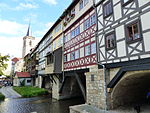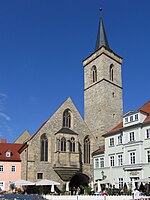Evangelical Church in Central Germany
2009 establishments in GermanyChristian organizations established in 2009Christianity in Saxony-AnhaltChristianity in ThuringiaGermany stubs ... and 5 more
Lutheran World Federation membersLutheranism stubsMember churches of the Evangelical Church in GermanyProtestant denominations established in the 21st centuryUnited and uniting churches

The Evangelical Church in Central Germany (German: Evangelische Kirche in Mitteldeutschland; EKM) is a United church body covering most of the German states of Saxony-Anhalt and Thuringia and some adjacent areas in Brandenburg and Saxony.
Excerpt from the Wikipedia article Evangelical Church in Central Germany (License: CC BY-SA 3.0, Authors, Images).Evangelical Church in Central Germany
Michaelisstraße, Erfurt Altstadt
Geographical coordinates (GPS) Address Nearby Places Show on map
Geographical coordinates (GPS)
| Latitude | Longitude |
|---|---|
| N 50.9796 ° | E 11.02805 ° |
Address
Kirchenamt der Ev. Kirche Mitteldeutschland (EKM) (Landeskirchenamt)
Michaelisstraße 39
99084 Erfurt, Altstadt
Thuringia, Germany
Open on Google Maps











